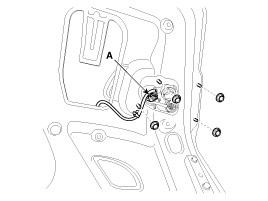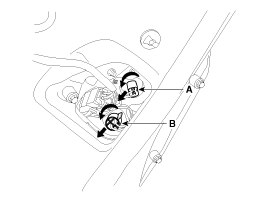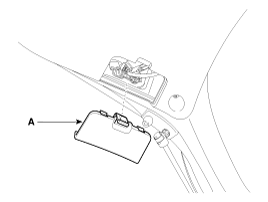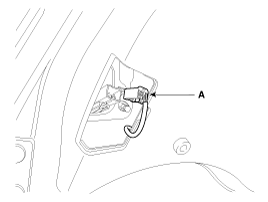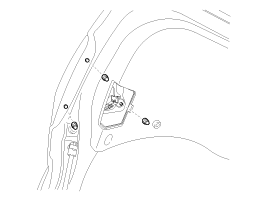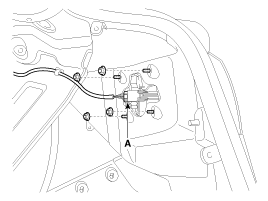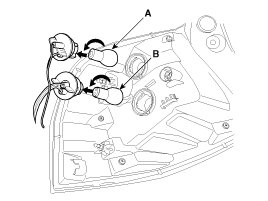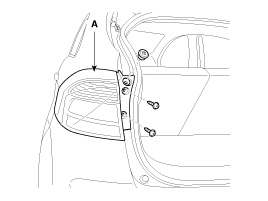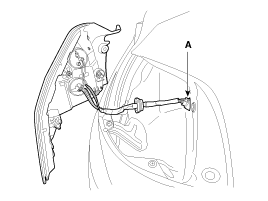 Kia Rio: Rear combination lamp Removal
Kia Rio: Rear combination lamp Removal
| Rear combination lamp (Inside) |
[4 Door]
| 1. |
Disconnect the negative (-) battery terminal.
|
| 2. |
Remove the trunk trim.
(Refer to the BD group - "Trunk")
|
| 3. |
Remove rear combination lamp after removing the mounting nuts
(4EA) and disconnecting the connector (A).
|
| 4. |
Remove the tail lamp bulb (A) and backup lamp bulb (B) after turning
in the counterclockwise direction.
|
| 5. |
If necessay to remove the bulb, remove the bulb after removing
the trunk trim
|
[5 Door]
| 1. |
Disconnect the negative (-) battery terminal.
|
| 2. |
Remove the lamp cover (A).
|
| 3. |
Remove rear combination lamp after removing the mounting nuts
(3EA) and disconnecting the connector (A).
|
| 4. |
Remove the tail lamp bulb (A) and backup lamp bulb (B) after turning
in the counterclockwise direction.
|
| 5. |
If necessay to remove the bulb, remove the bulb after removing
the lamp cover.
|
| Rear combination lamp (Outside) |
[4 Door]
| 1. |
Disconnect the negative (-) battery terminal.
|
| 2. |
Remove rear combination lamp after removing the mounting nuts
(4EA) and disconnecting the connector (A).
|
| 3. |
Remove the turn signal lamp bulb (A) and tail/ stop lamp bulb
(B) after turning in the counterclockwise direction.
|
| 4. |
If necessary to remove the bulb, remove the bulb after pulling
the trim cover aside.
|
[5 Door]
| 1. |
Disconnect the negative (-) battery terminal.
|
| 2. |
Remove the rear combination lamp (A) after removing the mounting
screws.
|
| 3. |
Disconnect the rear combination lamp connector (A).
|
| 4. |
Remove the turn signal lamp bulb (A) and tail/ stop lamp bulb
(B) after turning in the counterclockwise direction.
|
| 5. |
If necessary to remove the bulb, remove the bulb after pulling
the trim cover aside.
|
 High Mounted stop lamp Installation
High Mounted stop lamp Installation
[4 Door]
1.
Install the high mounted stop lamp assembly.
2.
Install the package tray trim.
3.
Connect the n ...
 Rear combination lamp Installation
Rear combination lamp Installation
Rear combination lamp (Inside)
[4 Door]
1.
Install the rear combination lamp assembly.
2.
Connect the rear combination connecto ...
See also:
Tightening Torques
Engine Control System
Item
kgf.m
N.m
lb-ft
ECM installation bolt
1.0 ~ 1.2
9.8 ~ 11.8
7.2 ~ 8.7
ECM bracket installation ...
Blower Resistor (MANUAL) Replacement
1.
Disconnect the negative (-) battery terminal.
2.
Disconnect the connector (A) and then remove the blower resistor
(B) after loosening th ...
SRS Control Module (SRSCM) Variant coding
After replacing the SRSCM with a new unit, the УVariant CodingФ procedure
must be performed.
1.
...
Copyright © www.kirmanual.com 2014-2024

